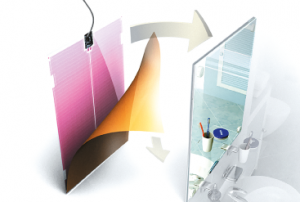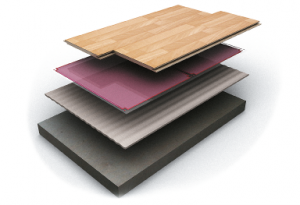In a world where energy efficiency and thermal comfort have become major concerns, heating technologies have evolved to meet these demands. Among these innovations, radiant film heaters stand out as a promising solution, offering a unique combination of performance, durability and efficiency. In this article, we take an in-depth look at this technology, its benefits and its potential to revolutionize heating.

What is Radiant Heating Film?
Radiant film heating is a modern heating technology based on the principle of infrared radiation. Unlike conventional heating systems that heat the ambient air, radiant heating films emit infrared rays that heat objects and people in a room directly. These films, generally thin and flexible, are composed of electrically conductive materials encapsulated between two layers of resistant plastic film.
The operation of these films is relatively simple. When an electrical voltage is applied, the conductive elements inside the film generate heat by the Joule effect. This heat is then radiated in the form of infrared radiation, providing a natural, direct sensation of warmth.
One of the distinguishing features of radiant film heaters is their ability to produce uniform heat across their entire surface. This eliminates common problems associated with other heating methods, such as hot or cold spots. What’s more, because these films can be cut and adapted to different shapes and sizes, they offer great installation flexibility, making them ideal for a variety of applications, from underfloor heating to radiant ceilings and walls.
Advantages of Radiant Heating Films
The growing adoption of radiant film heaters in a variety of applications is no accident. This technology offers several distinctive advantages that make it superior to many traditional heating methods.
- Energy efficiency and cost reduction: One of the key benefits of radiant film heaters is their exceptional energy efficiency. By heating objects and people directly, rather than the ambient air, they minimize energy losses. This translates into lower energy consumption and, consequently, lower electricity bills. What’s more, their ability to heat up quickly means shorter running times, contributing to further savings.
- Thermal comfort and even heat distribution: Radiant heating films provide a natural feeling of warmth, similar to that felt under the sun’s rays. This heat is also distributed evenly over the entire surface of the film, guaranteeing a constant temperature throughout the room. This eliminates the temperature variations often encountered with other heating systems.
- Flexibility of installation and use: Thanks to their slim, flexible design, radiant film heaters can be installed in a variety of spaces, whether floors, walls or ceilings. This versatility means they can be adapted to almost any room configuration, whether for renovation or new construction. What’s more, installation is generally straightforward, requiring no major work or structural modifications.
- Durability and low maintenance: Designed to last, radiant heaters are tough and durable. Their absence of moving parts reduces the risk of breakdowns, ensuring long life with minimum maintenance. What’s more, because they don’t move air like convection heating systems, they don’t disperse dust or allergens, contributing to a healthier indoor environment.

Comparison with other heating methods
While radiant heating foils offer many advantages, how do they compare with traditional heating methods? Conventional heating systems, such as radiators or central heating systems, work mainly by convection. This means they heat the ambient air, which in turn heats the objects and people in the room. This method has several drawbacks.
Firstly, convection heating can result in uneven heat distribution, with warmer areas near the heat source and cooler areas further away. What’s more, these systems can take a long time to heat up a room, especially in large spaces.
In contrast, radiant heating foils provide direct heat, guaranteeing even heat distribution throughout the room. They also heat up faster, providing immediate comfort. What’s more, they’re generally more energy-efficient, since they minimize energy losses associated with air heating.
Applications and uses of heating and radiant films
Thanks to their flexibility and efficiency, radiant heating films can be used in a multitude of applications, from private residences to commercial and industrial spaces.
- Private homes: In the residential context, radiant heating films are often used for floor heating. They can be installed under different types of flooring, such as tiles, parquet or even carpet. Thanks to their uniform heat distribution, they guarantee optimum comfort, especially during the winter months. What’s more, they can be installed in specific rooms, such as bathrooms, where thermal comfort is essential.
- Commercial spaces: Offices, stores and other commercial spaces can benefit from the advantages of radiant heating films. In these environments, occupant comfort is crucial to productivity and customer satisfaction. Thanks to their ability to deliver rapid, even heat, radiant film heaters are an ideal solution. What’s more, their low running costs can result in significant savings for companies.
- Industrial installations: In the industrial sector, radiant heating films can be used for specific applications, such as maintaining temperature in certain areas or heating large warehouses. Their ability to deliver targeted heat makes them particularly useful in environments where precise temperature control is essential.
- Other applications: In addition to the applications mentioned above, radiant heating films can also be used in settings such as greenhouses, where they can help maintain a constant temperature for plant growth. They can also be used in outdoor environments, such as terraces or parking areas, to prevent the build-up of ice or snow.
Don’t hesitate!
Radiant film heaters represent a major advance in the field of heating. Thanks to their innovative design and energy efficiency, they offer a superior heating solution to many traditional methods. Whether for the comfort of a home, the efficiency of a commercial space or the specific needs of an industrial installation, radiant heating films are positioning themselves as the technology of choice for the future of heating.

